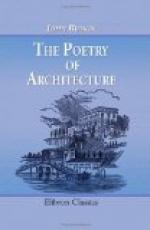48. When such a prospect is not attainable, one of the chief uses of the mountain cottage, paradoxical as the idea may appear, is to increase this sense of solitude. Now, as it will only do so when it is seen at a considerable distance, it is necessary that it should be visible, or, at least, that its presence should be indicated, over a considerable portion of surrounding space. It must not, therefore, be too much shaded by trees, or it will be useless; but if, on the contrary, it be too conspicuous on the open hillside, it will be liable to most of the objections which were advanced against the Swiss cottage, and to another, which was not then noticed. Anything which, to the eye, is split into parts, appears less as a whole than what is undivided. Now, a considerable mass, of whatever tone or color it may consist, is as easily divisible by dots as by lines; that is, a conspicuous point, on any part of its surface, will divide it into two portions, each of which will be individually measured by the eye, but which will never make the impression which they would have made, had their unity not been interrupted. A conspicuous cottage on a distant mountain side has this effect in a fatal degree, and is, therefore, always intolerable.
49. It should accordingly, in order to reconcile the attainment of the good, with the avoidance of the evil, be barely visible: it should not tell as a cottage on the eye, though it should on the mind; for be it observed that, if it is only by the closest investigation that we can ascertain it to be a human habitation, it will answer the purpose of increasing the solitude quite as well as if it were evidently so; because this impression is produced by its appeal to the thoughts, not by its effect on the eye. Its color, therefore, should be as nearly as possible that of the hill on which, or the crag beneath which, it is placed; its form, one that will incorporate well with the ground, and approach that of a large stone more than of anything else. The color will consequently, if this rule be followed, be subdued and grayish, but rather warm; and the form simple, graceful, and unpretending. The building should retain the same general character on a closer examination. Everything about it should be natural, and should appear as if the influences and forces which were in operation around it had been too strong to be resisted, and had rendered all efforts of art to check their power, or conceal the evidence of their action, entirely unavailing. It cannot but be an alien child of the mountains; but it must show that it has been adopted and cherished by them. This effect is only attainable by great ease of outline and variety of color; peculiarities which, as will be presently seen, the Westmoreland cottage possesses in a supereminent degree.




